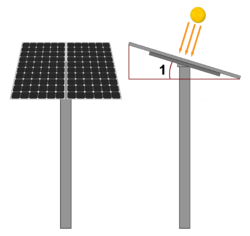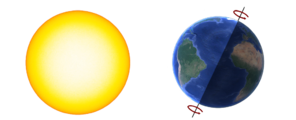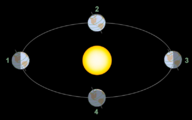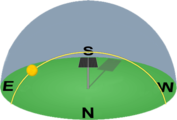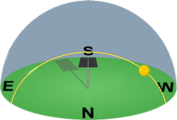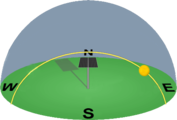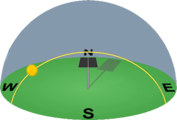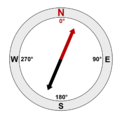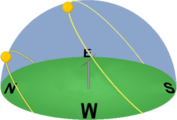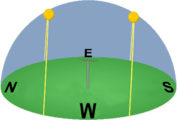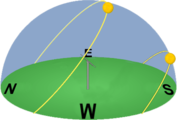Tilt and azimuth
The sunlight that reaches the earth is strongest when it strikes a surface perpendicularly (with an angle of 90°), yet the position of the sun in the sky varies through the day and through the year for every location. This means that to capture as much sunlight as possible and maximize production, a PV module must be properly positioned. There are two important ways in which a PV module can be positioned relative to the sun:
- Direction relative to the cardinal directions (North, East, South, West).
- Angle relative to the surface of the earth.
Understanding the ideal orientation and angle requires a basic understanding of the earth's daily and annual movements.
Contents
Movements of the earth
The earth is at all times rotating around its own axis (completing a full rotation approximately every 24 hours) and orbiting around the sun (completing a full orbit approximately every 365 days).
Daily rotation
The earth completes a full revolution around its own axis approximately every 24 hours. This causes the strength of the sun to vary throughout the day as it arcs through the sky, rising in the East and setting in the West. The strength of the sun's rays peak when it is at the top of its arc between East and West at around 12:00.
Yearly orbit
The earth rotates around the sun in a nearly perfect circle one time every 365 days. The yearly orbit of the earth around the sun accounts for the variation in the strength of the sun in different areas between the seasons. The earth's axis is at an angle, roughly 23.5°, which creates seasonal variation as the angle of the sun's rays striking any location on earth varies depending upon the position of the earth in its orbit around the sun. This also has an effect on the number of hours of light that a location receives each day, which becomes more pronounced moving further away from the equator. June 21 in the Southern hemisphere is the shortest day of the year and December 21 is the longest day of the year. The opposite is true in the Northern hemisphere.
Left: June 21 - The Northern hemisphere is tilted towards the sun and therefore receives more direct sunlight and has more daylight each day than the Southern hemisphere.
Right: December 21 - The Southern hemisphere is tilted towards the sun and therefore receives more direct sunlight and has more daylight each day than the Northern hemisphere.
Azimuth angle
The most important period for PV system production is between 9:00 and 15:00. At 9:00 the sun is rising in the East and gaining strength. At around 12:00 the sun is reaching the peak if its arc in the sky between East and West. In the Southern hemisphere, the position of the sun in the sky is due North at this point. In the Northern hemisphere it is due South. At 15:00 the sun is beginning to fall towards the West and is losing strength. To maximize the amount of sunlight that a PV module captures, it is ideal to if it is pointed with an azimuth angle of due North (0°) in the Southern hemisphere and due South (180°) in the Northern hemisphere as this enables the PV module to capture the maximum amount of sunlight as the sun arcs from East to West. Additionally, if the PV module is properly facing either of these directions it it will be able to take maximum advantage of the sun's rays when it is at its strongest.
Southern hemisphere: A PV module on a fixed mounting structure will maximize yearly production by facing directly towards the North:
June 21, 9:00 in Quelimane, Mozambique (17°S). The sun rises in the East.[1]
June 21, 15:00 in Quelimane, Mozambique (17°S). The sun descends in the West.[1]
Northern hemisphere: A PV module on a fixed mounting structure will maximize yearly production by facing directly towards the South:
Dec 21, 9:00 in Oaxaca, Mexico (17°N). The sun rises in the East.[1]
Dec 21, 15:00 in Oaxaca, Mexico (17° N). The sun descends in the West.[1]
Magnetic declination
A compass is necessary to determine the cardinal directions in order to point PV in the right direction. PV modules maximize production when pointed true North or South, but an unadjusted compass provides magnetic North or South which can vary significantly depending on the magnetic field in the location where the PV system is being installed. The adjustment factor between magnetic North and true north is called magnetic declination. This value can be found on some paper maps, but the most accurate and easiest source is the internet. There are many different free tools such as the NOAA Magnetic Declination Tool.
Non-standard azimuth angles
In some cases, it is not possible or not convenient to face a PV module true North/South. If an array is slightly off from true North/South it is unlikely to affect production greatly in any case, but the effect does become more pronounced moving further from the equator. How much production is affected varies significantly, for example:
- A system with a tilt of 5° facing true East (90°) or true West (270°) at 0° latitude will produce an estimated 5% less than a system facing true North (0°).[2]
- A system with a tilt of 17° facing true East (90°) or true West (270°) at 17°S latitude will produce an estimated 7.7% less than a system facing true North (0°)[2]
- A system with a tilt of 41° facing true East (90°) or true West (270°) at 41°S latitude will produce an estimated 19.8% less than a system facing true North (0°)[2]
Tilt angle
The path that the sun takes through the sky changes each day as the earth moves through its orbit. The change becomes more pronounced as one moves away from the equator. A PV module is able to collect the most energy as the sun changes position in the sky throughout the year if a PV module is placed at an angle that is equivalent to the latitude of the location. At the equator it is important to still tilt the panel with at least a 5° tilt to ensure that water will run off the panel to shed dust.
Pole mount system with a tilt of 41° with true North azimuth (0°). The path of the sun in Bariloche, Argentina 41°S at 12:00 on December 21 (summer solstice) and June 21 (winter solstice).[1]
Pole mount system with a tilt of 5° with true South azimuth (180°). The path of the sun in Kampala, Uganda .3°N at 12:00 on December 21 and June 21.[1]
Pole mount system with a tilt of 41° with true South azimuth (180°). The path of the sun in the Gobi Desert, Mongolia 41°N at 12:00 on December 21 (winter solstice) and June 21 (summer solstice).[1]
Non-standard tilt angles
Under some conditions it makes sense to use a tilt for a PV module that is different than latitude.
- It is often the simplest, cheapest and most theft-proof option to install PV modules on the roof of a home. In this case, typically the angle of the existing roof is used as the tilt angle for the PV module. An 17° latitude, an PV module with a tilt angle of 7° will only produce an estimated 2.1% less than a PV module with a tilt angle of 17°.[2]
- Mounting systems are frequently build that enable users to change the angle of the PV modules through the course of the year to maximize production at higher latitudes. The standard array angle adjustment is +15° at the fall solstice and -15° at the spring solstice. At 41° latitude, a system that is adjusted at the two solstices will produce an estimated 6% more than a system that is at a fixed 41° tilt. This additional energy can be crucial in the winter.[2]
- If PV system is only going to be used seasonally then mounting the PV modules at an angle that maximizes production during that time of the year is advisable.
- As was mentioned previously, it is not advisable to mount PV modules at an angle of 0° near the equator as they are unable to shed water and will lose significant production as they become increasingly soiled. At least a 5° angle is recommended.
Notes/references
NOAA Magnetic Declination Tool https://www.ngdc.noaa.gov/geomag/calculators/magcalc.shtml#declination
